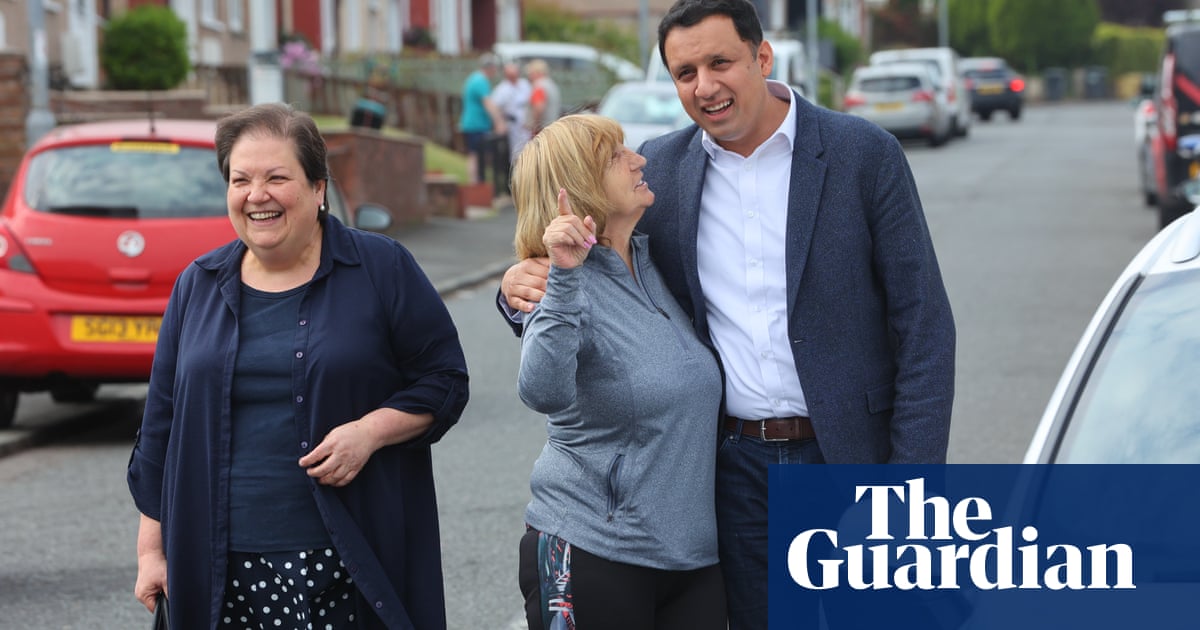
Within 48 hours of the election being called, both main party leaders travelled to Scotland, keen to capitalise on the decline in support for the Scottish National party, which has dominated elections at Holyrood and Westminster for more than a decade. But the campaign has revealed that Scottish votes matter to parties for very different reasons.
SNP
The Nationalists have the most to lose. They reached an extraordinary high-water mark of 56 out of then 59 seats in 2015, when the party channelled the fervour of yes supporters who lost out in the independence referendum the previous year. When Sunak called the election, they had 43 MPs, and the only way is down.
Campaign attack lines suggesting there is little difference between Starmer and Sunak have been undermined by the Nationalists’ faltering record at Holyrood and allegations of financial corruption. Core supporters, disappointed by a lack of progress on independence, may stay at home on polling day.
With a resurgent Scottish Labour three points ahead of the SNP on average since the start of the campaign, the polling guru Sir John Curtice argues that, because of the concentration of Labour support in the central belt, they will probably be better at converting their votes into seats and are likely to re-emerge as largest party. Polls have estimated that the SNP’s total number of seats will be between the low teens and mid-20s.
Insiders with knowledge of previous SNP campaigns suggest that even previously safe seats are now on a knife-edge and that any result above 20 would be welcome, spun as a necessary correction after exceptional success.
The position of the party’s leader, John Swinney, is unlikely to be affected, as he has only just taken possession of the keys to Bute House following Humza Yousaf’s resignation. The same insiders argue that he now has 18 months to establish himself before the 2026 Holyrood election campaign, when the SNP may benefit from buyers’ remorse felt by voters who find that a Labour government in Westminster does not offer radical change quickly enough.
There is minimal concern within the SNP that significant numbers of their voters are turning to Alba, another pro-independence party set up by former leader Alex Salmond.
Labour
Keir Starmer has been hammering the message for more than a year that the road to Downing Street runs through Scotland – and while landslide predictions may suggest that the Commons arithmetic doesn’t require the numbers in Scotland, the Labour leader has described his desire to win here as “personal”.
For Starmer, this is about mandate and credibility – winning back Scotland after a series of brutal electoral humiliations at the hands of the SNP is key to his own trajectory as UK Labour leader. This was evident in the resources and activist energy poured into the Rutherglen byelection campaign last autumn, resulting in an emphatic 20% swing from the Nationalists.
Previous accusations that the party was taking Scottish votes for granted have been snuffed out by regular visits from senior UK figures such as Angela Rayner and Rachel Reeves throughout the campaign, while Starmer’s close relationship with the Scottish leader, Anas Sarwar, has helped him reflect the political tone in Scotland.
Both men have been clear that change in Scotland is a two-stage process. Sarwar’s first goal is to end nearly two decades of SNP residency in Bute House in 2026.
Conservatives
Although the past 18 months have seen a significant shift in Scottish politics, with voters’ constitutional preferences decoupled from their choice at the ballot box, Curtice argues that this has happened only for independence supporters. “For those on the unionist side, the constitution really does still matter,” he said.
Hence the recurring joke that the Scottish Tories mention independence in their campaign material more often than the SNP do. But party sources say fear of another referendum is still a driver for a tranche of pro-union voters, suggesting that those in border seats in particular are unimpressed with Labour’s rhetoric, which has made appeals to independence supporters, asking them to “come along for this part of the journey”. Similarly, the Tories claim to speak for the oil and gas sector and Brexit supporters in north-east constituencies.
Although Reform is standing candidates in every Scottish seat, it has not had the same impact as in the rest of the country, and recent Scotland-only polling puts the party at a high of 8%. Nonetheless, senior Scottish Conservatives last week warned pro-union voters that even a “handful of votes” for Reform would hand victory to the Nationalists in their 12 target seats.
The Scottish Tory party has struggled with Westminster’s scandals, gambling having proved particularly unhelpful on the doorstep, as well as with their own internal strife. The leader, Douglas Ross, announced his surprise resignation midway through the campaign after a backlash from colleagues when he broke his promise to return to Holyrood to focus on the 2026 election.
Scottish Liberal Democrats
The UK leader, Ed Davey, kicked off the final days of campaigning in Scotland this weekend. The party’s six target seats are vital to returning it to the position of third largest party in the Commons, after it was usurped by the SNP in 2015. The Lib Dems have sorely missed the status and profile attached to this ranking, as well as the weekly exposure of a guaranteed slot at prime minister’s questions.
Scottish seats have always provided a significant proportion of the Lib Dem total, and campaign sources suggest that their base is holding up. They also point out that the Scottish electorate is a sophisticated one, voting tactically for the local pro-union candidate most likely to win, which might also affect a uniform swing to Labour in Scotland.
While the party in Scotland has been hurt by boundary changes that have meant they will be starting from behind in seats in the Highlands and North East Fife where they were previously ahead, any wins that knock out an SNP MP will be prized as counting for double, adding to the Lib Dem total while reducing that of the Nationalists.
Scottish Greens
Despite standing the highest number of candidates ever at a general election, in 44 constituencies, the pro-independence Scottish Greens have no expectation of winning a Westminster seat. Nevertheless, this campaign will be a crucial data-gathering exercise to help consolidate and build support before 2026 as well as the council elections in 2027.
Since Yousaf abruptly ended the governing partnership with the Scottish Greens in April, prompting a threatened no confidence vote which led to his resignation, the party has been appealing to SNP supporters disaffected with the Scottish government’s ditching of climate targets and, they argue, its drift to the centre right under Swinney.
While independence supporters have tended to stick with the SNP in Westminster elections, one senior party source signalled a “noticeable movement’ to the Greens this time: “Those floating progressive independence voters are not sure who the SNP are or what they stand for now.”












